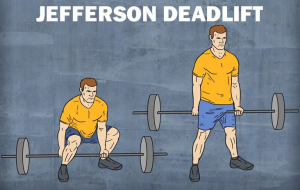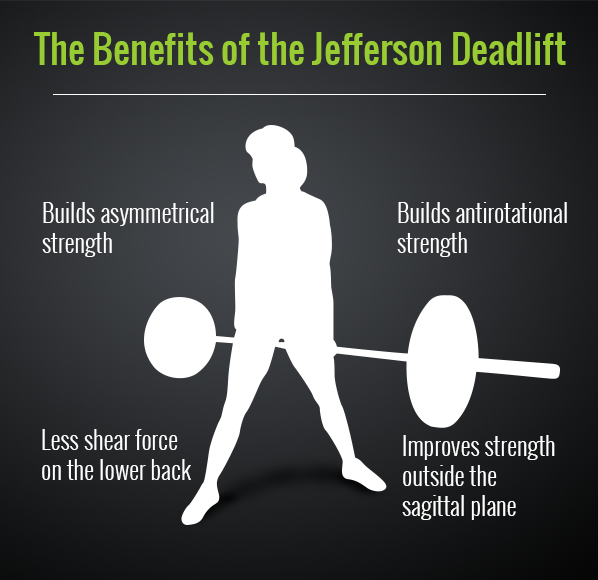The Jefferson Deadlift

Sometimes, the weirdest-looking exercises can be the most useful, and the Jefferson deadlift is the perfect example.
It’s weird. There’s about a one hundred percent chance you’ll attract looks in the gym. But it has some pretty extraordinary benefits.
The Jefferson Deadlift combines asymmetry, rotation, hip hinging, and heavy loading all at once. The lift is similar to a trap bar deadlift, so there’s less shear force on the spine, but it involves rotation, so it’s a multiplanar exercise that builds asymmetrical and anti-rotational strength. Because the feet are staggered, your torso will want to turn to face the same direction as the feet, and to keep your chest facing forward, you’ll need to engage your deep core stabilisers.
If your conventional deadlift numbers are stalling or they’re causing back pain, spending a few weeks working with Jefferson deadlifts may be an effective way to break through a plateau or reduce or eliminate pain. Here’s how to do it.

How to Do It
Straddle the bar with your feet shoulder width or a little wider, grab it beneath your shoulders, and stand up. Make sure the weight is centred between both feet, and take care your knees don’t cave inward when you start pulling.
You can experiment with different grips, but try to stay relatively balanced by alternating your front and back foot for equal amounts of time. An exception to this rule is if you have a severe asymmetry, like scoliosis, in which case it’s best to train the side that feels more comfortable once your doctor gives the go-ahead.
As is the case with the trap bar deadlift, the Jefferson should be closer to a squat than a hinge. (In fact, it’s sometimes called the Jefferson squat.) If you’re leaning forward a lot in a hinge motion, it’s possible you won’t have good leverage.
Common Sticking Points
The most common form mistake is letting the heel of the back foot lift up. That means you aren’t firmly grounded with both feet, and you’re putting more weight on one leg than the other.
Despite its awkward and off-balance appearance, the Jefferson should load both legs pretty symmetrically. If it isn’t, you are probably set up with a foot too far behind them. Moving the feet more in line with each other while keeping them roughly shoulder width or a little wider will get the job done better.
When to Do It
As mentioned above, it’s a great way to train the legs and back with less shear force on the spine. Studies have found that for many people with back pain, concentrating on the Jefferson for a few weeks can help them return to conventional deadlifts pain-free.
It’s also great for busting through strength plateaus.
For my powerlifters, when they’re in their off-season or they don’t have a meet for a couple of months, they’ll trade out their normal deadlift stance for a Jefferson and train with low reps. They do that for, like, four weeks. If they’ve stalled in their deadlift progress, getting stronger in a different stance and bumping up their best sumo and best Jefferson inevitably breaks through their plateau in the conventional deadlift.
Finally, if nothing else, it’s a dynamite accessory movement for developing the quads, which is one of the reasons bodybuilder Kai Greene is such a fan of the exercise.
Summary
In short, its strength is its weirdness. It’s one of the few asymmetrical and anti-rotational movements that allows serious weight to be lifted. It fits neatly into powerlifting and strength training plans, it’s easy on the back, and it allows for some variety in the old squat, dead, and bench rotation.
When you’re straddling the bar, enjoy the looks. Given all of the benefits of the Jefferson deadlift, you can be weird with pride.